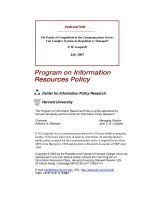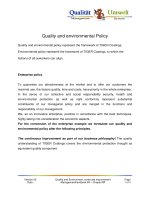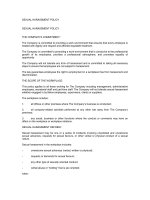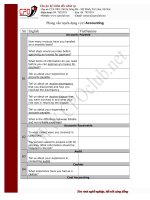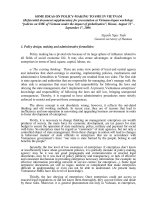Act accounting policy
Bạn đang xem bản rút gọn của tài liệu. Xem và tải ngay bản đầy đủ của tài liệu tại đây (94.33 KB, 15 trang )
ACT ACCOUNTING POLICY
HERITAGE AND COMMUNITY
ASSETS
For Reporting Periods Ending on or after 30 June 2009
ACT Accounting Policy – Heritage and Community Assets
TABLE OF CONTENTS
1
INTRODUCTION..................................................................................................... 1
1.1 APPLICATION ........................................................................................................ 1
1.1.1 This Policy ................................................................................................ 1
1.1.2 Relationship to International Financial Reporting Standards................. 1
1.1.3 Application Date....................................................................................... 1
2
ACT ACCOUNTING POLICIES ........................................................................... 1
2.1 DEFINITION OF HERITAGE AND COMMUNITY ASSETS ........................................... 1
2.1.1 Heritage Assets......................................................................................... 2
2.1.2 Community assets ..................................................................................... 2
2.1.3 Classification............................................................................................ 2
2.2 RECOGNITION OF HERITAGE AND COMMUNITY ASSETS ....................................... 2
2.3 MEASUREMENT OF HERITAGE AND COMMUNITY ASSETS ..................................... 8
2.3.1
2.3.2
2.3.3
2.3.4
2.3.5
2.3.6
2.3.7
2.3.8
Measurement of Heritage and Community Assets.................................... 8
“Highest and Best Use” ........................................................................... 8
Guidance for Valuers of Heritage and Community Assets....................... 9
Heritage and Community Assets which cannot be Measured .................. 9
Nominal Value .......................................................................................... 9
Measurement of Collections ................................................................... 10
Measurement of Trees ............................................................................ 10
Items Measured as part of Community Assets........................................ 12
2.4 MAINTENANCE/REPLANTING OF TREES .............................................................. 12
2.5 TRANSFER OF HERITAGE AND COMMUNITY ASSETS ........................................... 12
2.6 DEPRECIATION .................................................................................................... 13
i
ACT Accounting Policy – Heritage and Community Assets
1 Introduction
1.1
Application
1.1.1
This Policy
This ACT Accounting Policy applies to heritage and community assets held by
departments and Territory authorities. When accounting for heritage and community
assets agencies must follow the relevant Australian Equivalents to International Financial
Reporting Standards (AIFRS). Consequently, this Policy is to be read in conjunction
with the following:
•
AASB 116
Property, Plant and Equipment;
•
AASB 136
Impairment of Assets; and
•
AASB 1045 Land Under Roads: Amendments to AAS 27A, AAS 29A and AAS
31A.
1.1.2
Relationship to International Financial Reporting Standards
ACT Accounting Policies are to be read in conjunction with the applicable AIFRS. The
policies provide additional ACT specific accounting principles and guidance over and
above those contained in the AIFRS, both of which must be applied by ACT agencies.
There is, however, no intention that the ACT Accounting Policies will replicate the
AIFRS. Consequently, agencies should ensure that they have a good understanding of
the content of AIFRS before reading and applying relevant ACT Accounting Policies.
1.1.3
Application Date
This ACT Accounting Policy Paper will apply to reporting periods beginning on or after
1 July 2008.
2 ACT Accounting Policies
2.1
Definition of Heritage and Community Assets
Heritage and community assets are defined below in Section 2.1.1 ‘Heritage Assets’
and Section 2.1.2 ‘Community Assets’. The definitions are ACT Accounting Policy as
the AIFRS do not define heritage and community assets.
1
ACT Accounting Policy – Heritage and Community Assets
2.1.1
Heritage Assets
The terms heritage asset or cultural asset refer to assets that have unique cultural,
historical, geographical, scientific, and/or environmental attributes that the Government
intends to preserve indefinitely because of those attributes.
They are not usually available for sale or alternative use. The agency responsible under
statute or Administrative Arrangement Orders for the provision of a particular service
would normally control the heritage assets linked to that service.
Heritage assets may include:
•
•
•
•
•
art, museum and library collections;
historical buildings;
monuments;
certain land which will be preserved in its existing state to maintain the historic
value to the Territory; and
other cultural assets.
The service potential of a heritage asset lies in its aesthetic utility, that is, it is of historical
significance or fulfils a social need that is either cultural or environmental. There need
not be a functional purpose outside that utility (although some heritage assets may also
provide a functional service that can be associated with financial returns).
2.1.2
Community assets
Community assets are those assets that are provided essentially for general community
use or service. Such assets would include:
• rural recreational reserves and picnic/camping areas;
• nature reserves;
• national parks;
• urban parks and sportsground; and
• land under roads.
2.1.3
Classification
Heritage and community assets meet the definition of Property, Plant and Equipment
(PPE) in AASB 116 para 6 and as such should be classified/disclosed as part of PPE (also
see ‘ACT Accounting Policy Paper – Property, Plant and Equipment’ paragraph 2.1.1
Asset Classes).
2.2
Recognition of Heritage and Community Assets
AASB 116 paragraph 7 outlines the recognition criteria for PPE. In addition to these
recognition criteria, ACT Accounting Policy also requires agencies only recognise
heritage and community assets which are above that agency’s capitalisation threshold.
ACT Government agencies must choose a capitalisation threshold between $2,000 and
$5,000 inclusive. For further discussion see ‘ACT Accounting Policy Paper – Property,
2
ACT Accounting Policy – Heritage and Community Assets
Plant and Equipment’ paragraph 2.1.2 Initial Recognition of Property, Plant and
Equipment.
Based on the recognition criteria for PPE outlined in AASB 116 para 7, the tables below
outline which land assets should be recognised in an agency’s financial report. Note that
the below tables do not include a comprehensive list of all areas that could be included in
each category.
Category 1
Category
National Parks
Description
A protected area of IUCN (International Union for the Conservation of Nature and Natural Resources) Category
II land, reserved and managed through legislation to protect and maintain the area’s biological diversity, conserve
its natural and cultural heritage and provide for compatible cultural, recreational, educational and scientific use
opportunities.
Example of Areas that fall within the Category
•
Namadgi National Park
Accounting Treatment
These areas should be recognised as a Heritage and Community asset (where they are over the capitalisation
threshold).
This is because they provide future economic benefit (or service potential) in the form of recreational and
environmental benefits to the community resulting in the agency achieving its objectives. Also, as a general rule
the Australian Valuation Office (AVO) has indicated that these areas can be measured reliably1.
Category 2
Category
Nature Reserves
Description
Nature reserves are areas of land in a predominantly untouched, natural condition which has high conservation
value. Their primary purpose is to protect and conserve their outstanding, unique or representative ecosystems,
native plant and animal species or natural phenomena.
Scientific research is an important objective in nature reserves, as it increases our understanding of their values
and provides the information needed to conserve them.
1
Note, the AVO have indicated that in a number of cases a value will not be able to be determined for individual trees or larger groups
of trees which are held for their intrinsic heritage, cultural, scientific or aesthetic significance.
3
ACT Accounting Policy – Heritage and Community Assets
Example of Areas that fall within the Category
• Jerrabomberra Wetlands
• Black Mountain Nature Reserve
• Dunlop Grasslands
• Farrer Ridge Nature Reserve
• Isaacs Ridge Nature Reserve
• O’Connor Ridge Nature Reserve
• Mulligans Flat
• Urambi Hill
• The Pinnacle Nature Reserve
• Tidbinbilla Nature Reserve
Accounting Treatment
These areas should be recognised as a Heritage and Community asset (where they are over the capitalisation
threshold).
This is because they provide future economic benefit (or service potential) in the form of recreational and
environmental benefits to the community resulting in the agency achieving its objectives. Also, as a general rule
the AVO has indicated that these areas can be measured reliably2.
Category 3
Category
Rural Recreational Reserves and Picnic/Camping Areas
Description
Rural recreational reserves, picnic and camping areas that provide a rural recreational experience. These areas
are extensive informal reserves and picnic areas, with a diversity of recreation facilities for picnicking, barbecues,
swimming and wading, and adventure playgrounds.
Example of Areas that fall within the Category
• Stromlo Forest Park
• Cotter Recreation Reserve including Campground
• Uriarra Recreation Reserve
• Kambah Pool Recreation Reserve
• Pine Island Recreation Reserve
• Point Hut Recreation Reserve
• Molonglo Gorge Recreation Area
• Blue Range Recreational Area
• Murray's Corner Recreation Area
• Woods Reserve Recreation Area
Accounting Treatment
These areas should be recognised as a Heritage and Community asset (where they are over the capitalisation
threshold).
This is because they provide future economic benefit (or service potential) in the form of recreational benefits to
the community resulting in the agency achieving its objectives. Also, as a general rule the AVO has indicated
that these areas can be measured reliably2.
2
Note, the AVO have indicated that in a number of cases a value will not be able to be determined for individual trees or larger groups
of trees which are held for their intrinsic heritage, cultural, scientific or aesthetic significance.
4
ACT Accounting Policy – Heritage and Community Assets
Category 4
Category
Urban Parks and Sportsgrounds
Description
Urban Parks/ Sporting Areas are made up of a number of different areas including:
•
Town and District Parks - are formal parks managed to a high standard. They usually have mown and
irrigated grass, paving, sculpture, shrub or flower beds, adjacent to and serving the main town centres. They
have intensive use and may host special events.
•
Neighbourhood Parks - typically have playground facilities, are located within a 400m distance of
residential areas and reflect the character of the land and the neighbourhood.
•
District Sportsgrounds – are usually large (8ha or more) and have a number of playing fields that cater for
senior and junior competition. There high use means that toilets and pavilions are provided.
•
Neighbourhood Sportsgrounds – smaller ovals (approx 2ha in area) generally located near primary schools
and local shops. Used for organised activities by schools and informally by the local community.
•
Informal Use Oval - Non-irrigated open dryland grass areas located adjacent to primary schools, community
facilities or shopping centres. These areas provide for informal sport and recreational use by the local
community. An Informal Use Oval is considered to be an integral part of any surrounding parkland when
not in use for sporting purposes.
•
Enclosed Ovals – Higher quality grounds used only for competition. They are fenced with change rooms,
toilets, canteens and spectator seating and are only available on hire.
Example of Areas that fall within the Category
•
•
•
•
•
•
•
•
Town and District Parks
Neighbourhood Parks
Enclosed Ovals
Neighbourhood Sportsground
District Sportsgrounds
Informal Use Ovals
Showgrounds
Equestrian Parks
Accounting Treatment
These areas should be recognised as a Heritage and Community asset (where they are over the capitalisation
threshold).
This is because they provide future economic benefit (or service potential) in the form of recreational benefits to
the community resulting in the agency achieving its objectives. Also, as a general rule the AVO has indicated
that these areas can be measured reliably3.
3
Note, the AVO have indicated that in a number of cases a value will not be able to be determined for individual trees or larger groups
of trees which are held for their intrinsic heritage, cultural, scientific or aesthetic significance.
5
ACT Accounting Policy – Heritage and Community Assets
Category 5
Category
Land under Roads
Description
Land under roadways, and road reserves, including land under footpaths, nature strips and median strips.
Example of Areas that fall within the Category
•
•
•
Land under the Tuggeranong Parkway
Land under Hindmarsh Drive
Land under Streets within a Suburb
Accounting Treatment
AASB 2006-3 “Amendments to Australian Accounting Standards AASB 1045 ‘Land Under Roads: Amendments
to AAS 27A, AAS 29A and AAS 31A’” does not require land under roads to be recognised until after the 30 June
2008 financial year. Further advice will be issued in 2008-09 regarding the valuation of land under roads.
Category 6
Category
Commercial Plantations of Trees
Description
‘Commercial plantations’ are where the primary purpose of planting the trees is for sale. Trees in these areas are
for commercial extraction.
Example of Areas that fall within the Category
•
•
•
Kowen Forest
Stromlo
Pieces Creek and Uriarra
Accounting Treatment
These areas should be taken up as an asset but should not be taken up as a heritage and community asset because
they fall within the definition of a ‘commercial plantations’ and as such should be accounted for in accordance
with AASB 141 Agriculture.4
4
Note that this policy paper does not apply to trees which are part of a commercial plantation.
6
ACT Accounting Policy – Heritage and Community Assets
Category 7
Category
Land Intended for Residential Purposes
Description
Land Intended for Residential Purposes is land that has been identified for future land sales in the next 30 years as
set out in the Canberra Spatial Plan.
Example of Areas that fall within the Category
• Molonglo Valley
• Gungahlin
Accounting Treatment
These areas should not be taken up as a heritage and community asset. As the intention is that this land will be
used for future land sales, it will be recognised and measured as inventory.
Category 8
Category
Pedestrian Parkland and Semi-Natural Open Space5
Description
Pedestrian Parkland and Semi-Natural Open Space are made up of a number of different areas, including:
•
Pedestrian Parkland – spread throughout the suburbs. Usually containing a walkway/cycleway, this
parkland links shops, parks and schools with people’s homes.
•
Semi-Natural Open Space – includes small creek corridors, low hill tops and other semi natural landscapes
between suburbs.
•
Native Grassland or Woodland - Remnant grassland or woodland sites are important for nature conservation
purposes. Several proclaimed sites contain endangered plant species in the urban area.
Example of Areas that fall within the Category
•
•
•
•
Area around Lake Tuggeranong and Lake Ginninderra
Monash Hill
Simpsons Hill
The network of linear open space throughout most newer suburbs
Accounting Treatment
These areas should be recognised as a Heritage and Community asset (where they are over the capitalisation
threshold).
This is because they provide future economic benefit (or service potential) in the form of recreational and
environmental benefits to the community resulting in the agency achieving its objectives. Also, as a general rule
the AVO has indicated that these areas can be measured reliably6.
5
The “Pedestrian Parkland and Semi-Natural Open Space” Category incorporates some items classified by TAMS as “Urban Open
Spaces” but not all these items in that category.
7
ACT Accounting Policy – Heritage and Community Assets
2.3
2.3.1
Measurement of Heritage and Community Assets
Measurement of Heritage and Community Assets
AASB 116 para 29 allows an entity to choose between either the cost model or the
revaluation model as its accounting policy for measuring PPE and shall apply that policy
to an entire class of PPE. Due to the GAAP/GFS Harmonisation Project, ACT
Accounting Policy requires all agencies to use the revaluation model and as such all
Heritage and Community Assets shall be measured at fair value as at 1 July 2008.
After the fair value of these assets has been determined, they should be revalued based on
a 3 year valuation cycle. For further discussion see ‘ACT Accounting Policy Paper –
Property, Plant and Equipment’ Section 2.1.5 ‘Measurement after Initial Recognition’.
Fair value is determined by reference to the best available market evidence. Where
available, this should be based on the current market selling price for the same or a
similar type of asset. However, many types of heritage and community assets are of a
unique nature for which no market selling price can be observed or for which no relevant
market exists. In these circumstances, AASB 116 provides that the asset’s fair value can
be estimated using an income or depreciated replacement cost approach.
An asset may be valued at the cost of replacing it with a similar asset, which is not
identical but provides a similar benefit/function and state of wear and tear. Unique
items are not necessarily incapable of valuation. The service potential or cultural
significance may be compared to other items which, whilst different, have a similar level
of service potential or cultural significance. For example, a unique asset which
demonstrates clothes from a particular period may be replaced by a different piece of
clothing from that same period. However, if the clothing was held because a particular
person had worn it, the replacement item must relate to that specific person.
2.3.2
“Highest and Best Use”
Fair value should be determined having regard to the “highest and best use” for which
market participants would be prepared to pay.
However, a characteristic of many heritage and community assets is that they are held for
a specific purpose and therefore have socio-political restrictions on their use and disposal.
This being the case the ‘highest and best use’ can only be determined using ‘existing use’
as there is generally no feasible alternative uses for these assets. For example, ACT
Government agencies will need to measure community assets such as public parks and
gardens, public sporting reserves and land under infrastructure based on their “existing
use” as land zoned for community use rather than the potential use as residential or
commercial land.
6
Note, the AVO have indicated that in a number of cases a value will not be able to be determined for individual trees or larger groups
of trees which are held for their intrinsic heritage, cultural, scientific or aesthetic significance.
8
ACT Accounting Policy – Heritage and Community Assets
2.3.3
Guidance for Valuers of Heritage and Community Assets
The ‘ACT Accounting Policy Paper – Property, Plant and Equipment’ Section 2.3
Guidelines and Sample Letters for Instructing Valuers outlines guidance which agencies
can use when instructing valuers in relation to the valuation of their PPE.
2.3.4
Heritage and Community Assets which cannot be Measured
In certain cases the fair value (including the replacement value) of some heritage and
community assets will not be able to be reliably measured. This is because some items
are held for their intrinsic value rather than their financial value, for example, farm
machinery at Lanyon Homestead. However, it is only in rare cases that the fair value of
an item can not be determined.
Also unique items that have an iconic status will also be difficult to have a value
assigned. For example, Don Bradman’s cricket cap is an iconic item which would be
difficult to value. This is because a market buying and selling price would be difficult to
ascertain as there is no market transactions for this item and the replacement /
reproduction cost does not accurately represent the iconic status of the item as it would be
inexpensive to reproduce the item but the reproduction would not be the cap that was
worn by Don Bradman.
Where a heritage or community asset cannot be reliably measured it should not be
recognised in the financial report. Instead, it should be disclosed in the notes to the
financial report. Where a heritage or community asset is not recognised in the
financial report it is recommended that the agency have an external expert opinion
stating that the asset cannot be measured reliably. If no external expert opinion is
obtained the agency must be able to justify that the asset cannot be reliably measured
to the ACT Audit-Office.
Where heritage and community assets cannot be reliably measured the note disclosure
should include:
•
the nature and purpose of the asset;
•
the reason it could not be measured; and
•
where applicable, an estimate of the annual cost of maintenance or preservation.
2.3.5
Nominal Value
Heritage and community assets can no longer be assigned a nominal value as these assets
must be measured at fair value. As a result, where an agency changes its valuation
methodology from nominal value to fair value, and this results in a material change in
asset values, the change in measurement methodology will be accounted for as a change
in accounting policy under AASB 108 Accounting Policies, Changes in Accounting
Estimates and Errors. As such, the increase in asset values will be made in the current
financial year, and generally not retrospectively applied, as it will not be possible to
determine what the retrospective fair value of these assets would have been at the end of
prior periods.
9
ACT Accounting Policy – Heritage and Community Assets
2.3.6
Measurement of Collections
The fair value of a large collection of heritage assets may be difficult to measure due to
the large number of items in the collection. This being the case, agencies can use
sampling techniques for valuing collection items. As such collections are treated as a
single asset for the purpose of valuation. Agencies may individually value the “high
value” items in a collection at fair value and use a random sampling technique to value
the remainder of the collection (below a predetermined threshold).
Sampling
methodologies require technical expertise and involve a number of steps, such as
determining the collections to be sampled, the sample size, selecting the sample, valuing
the sample and extrapolating to determine the collection’s value.
Sampling
methodologies will consider the location, manner of storage, and the homogeneity of the
items within the collection as well as the expected range of values in the population to be
sampled.
2.3.7 Measurement of Trees
The value of trees should be included in the carrying amount of the land which the trees
are located on. That is, the initial cost of planting trees should be capitalised in the
value of the land on which the trees are planted. This does not apply to trees being
planted as part of a maintenance program (see Section 2.4 ‘Maintenance/Replanting of
Trees’). When considering the initial cost of tree planting, the costs associated with
earthworks should also be included. Earthworks can be distinguished into two separate
categories, that is, earthworks relating to plantings (for example, clearing the land), and
earthworks relating to erosion control. Both categories of earthworks are costs incurred
in the initial construction of the asset, and should therefore be capitalised.
Subsequent to initial recognition, trees will be revalued as part of the value of the land on
which the trees are planted and as such will not be depreciated. These trees will be
included in the ‘Land’ asset class. The Australian Valuation Office (AVO) is able to
provide a valuation for ‘vegetated land’ which includes both the land and trees. The
AVO have outlined four different methodologies which they are able to use for different
types of trees/vegetation present on land sites. These are outlined in the table below to
assist agencies when engaging a valuer (especially for those agencies that do not use the
AVO):
Methodology
Type of Trees/Vegetation
Valuation Method Used by AVO
Methodology 1
Stands
of
commercially
marketable trees with a
possibility
that
some
harvesting will be part of the
park operation.
Valued on the basis of sampling of
a defined area and applying the
market value rate per hectare to the
balance of similarly planted areas.
Methodology 2
Native open bush land (sparse
vegetation/open
woodland
grassland) where there is no
commercial market for the
Valued on the basis of sales of
similar land with similar vegetation
and the value of the trees would be
part of the land.
10
ACT Accounting Policy – Heritage and Community Assets
timber.
Methodology 3
Stands
of
commercially
marketable trees or trees that
have been specifically planted
for habitat or aesthetic value
where there is no possibility of
harvesting.
Valued on a sampling basis i.e. rate
per hectare for the supply,
establishment and planting of
saplings.
Methodology 4
Culturally significant trees i.e. Either the cost of replacement with
Lone Pine.
a cutting or other tissue from the
original specimen, or
acknowledgement that the tree
'cannot be reliably measured'.
To assist the valuer with the valuation, based on the above methodologies, it is
recommended that agencies keep cost data regarding seedlings, soil preparation,
earthworks, and nurturing of trees to the point of self sustainability.
Even though the AVO have provided the above methodologies, they have indicated
that while a valuer should make every effort to identify comparable sales evidence or
costs for valuation purposes, in a number of cases a value will not be able to be
determined for individual trees or larger groups of trees which are held for their
intrinsic heritage, cultural, scientific or aesthetic significance. Such a classification
does not imply that the particular item is ‘valueless’; it is, in fact, literally ‘invaluable’.
This classification should not be applied on the basis of an unsubstantiated opinion,
without some objective test of its truth. It is recommended that classification in this
manner should be supported by certification, by the relevant valuer, that:
•
•
•
no established secondary market exists from which an appropriate replacement
could be purchased;
it would not be possible to establish the costs of providing an acceptable
substitute; and
no identifiable regular cash flows are generated by the item, which could be
discounted to establish a reliable net present value.
If the valuer states that reliable measurement is not possible, agencies are required to
make the disclosures outlined in Section 2.3.4 Heritage and Community Assets which can
not be Measured above.
Note that the AVO has also indicated that they will not be able to provide a meaningful
split between the total revalued amount of land and trees into a land component and a tree
component which will result in agencies having difficulties in impairing the value of the
trees where required (see requirement in Section 2.4 ‘Maintenance/Replanting of Trees’).
11
ACT Accounting Policy – Heritage and Community Assets
2.3.8 Items Measured as part of Community Assets
The measurement of community assets only includes land and trees and does not include
other assets which maybe located on the land. For example, Weston Park is made up of
land, trees, play grounds, paths, BBQs, tables, car parks, toilet blocks, and fencing.
When valuing an area like Weston Park, it is only the land and trees which are included
in the value of the community asset. The other elements are included in the asset class to
which they relate (eg play grounds would be included in plant and equipment).
2.4
Maintenance/Replanting of Trees
The cost of replacing trees should be expensed where small numbers of trees are being
replaced in any one particular area. However, where a large number of trees are
replaced in one particular area then this would be considered a replacement of the
asset rather than just maintaining it and as such the costs involved should be
capitalised. Where, as part of a replacement, it is necessary to remove existing trees in
order to plant new trees, this cost can also be capitalised. However the cost of removing
trees can not be capitalised where no new trees are being planted in their place. Note that
an impairment loss should be taken up for the trees as soon as it is discovered that the
trees in the area have died or been destroyed. The AVO have indicated that they can not
provide an objective split between the land value and the tree value as part of their
normal valuation process (see Section 2.3.7 ‘Measurement of Trees’ above). This being
the case, it will be up to each agency to liaise with their valuers at the point in time an
area has died or been destroyed to arrive at an impairment value. Discussions with the
ACT Audit-Office should also occur at this point to facilitate a smooth audit process.
For example, where it has been discovered that a small number of trees have died in ten
different nature reserves around Canberra due to the drought and these trees are removed
and replaced with new trees, the cost of removing and replacing the trees should be
expensed. However, where 25% of Namadgi National Park is destroyed by fire and these
trees are going to be replaced, the cost of removing and replacing these trees can be
capitalised. The carrying value of the trees burnt down should be recognised as an
impairment loss (discussion should occur with the Valuer and the ACT Audit-Office).
2.5
Transfer of Heritage and Community Assets
Heritage and community assets are to be transferred at the fair value based on the
‘highest and best use’ of the transferor. The transferor agency must carry the heritage
or community asset being transferred at fair value in accordance with Section 2.3.1
Measurement of Heritage and Community Assets.
Where the transferee will use the transferred asset for the same purpose as the transferor,
the asset will continue to be held at the transferred amount. The same purpose does not
mean that the asset will be used in exactly the same way, for example a heritage building
designated for ‘community use’ can be used for a number of different purposes including
12
ACT Accounting Policy – Heritage and Community Assets
a child care centre, a community activity centre, a community theatre, a cultural or health
facility, an educational establishment, an office building and/or a place of worship.
Where the transferee will not use the transferred asset for the same purpose as the
transferor, the transferee should initially take up the asset at the transferor’s fair value.
Shortly after the transfer has occurred, the transferee should value the transferred asset
based on the transferee’s ‘highest and best use’ of the asset, taking account of any
restrictions placed on the asset. Note that this does not constitute a revaluation and as
such the entire class, to which the asset relates, does not also need to be revalued (as
stated in AASB 116 para Aus 15.3).
2.6
Depreciation
AASB 116 requires that a non-current asset that has a limited useful life be depreciated.
However some heritage and community assets may have very long and indeterminate
useful lives and where this is the case agencies should not depreciate these assets.
The following heritage and community assets generally have very long and indeterminate
useful lives and are therefore not depreciated:
•
•
•
•
•
Works of art;
Unique historical objects;
Rare books;
Iconic heritage assets; and
Any community or heritage land.
ACT Government agencies are required to assess the useful lives of all heritage and
community assets (including assets with definite and indefinite useful lives) at the end of
each financial year to ascertain whether the length of the assets useful lives are still
accurate.
13

